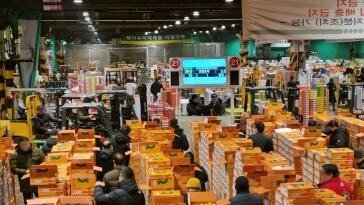Ninety-five years ago, March 25 also fell on a Saturday. At 4:40 p.m. on that sunny afternoon in 1911, only minutes before the end of the workday, a fire broke out on the eighth floor of the Asch Building, a block east of Washington Square in Manhattan.
The Triangle Waist Company occupied the top three floors of the 10-story building. There, some 600 workers were employed in the manufacture of ladies' shirtwaists, most of them teenage girls who spoke little English and were fresh off the boat from Russia, the Austro-Hungarian Empire 2) and Italy. The fire, probably caused by a carelessly tossed match or cigarette butt (there were perhaps 100 men working at the Triangle), engulfed the premises * in minutes.
The factory owners and the office staff on the 10th floor, all but one, escaped onto the roof and climbed to an adjacent building on Waverly Place. But on the eighth and ninth floors, the workers were trapped by a deadly combination of highly combustible * materials, workrooms crowded by dense rows of table-mounted sewing machines, doors that were locked or opened inward, inadequate fire escapes, and the lack of any plan or instruction.
Before the first horse-drawn fire engines arrived at the scene, girls - some holding hands, in twos and threes - had already begun to jump from the windows. The hundred-foot drop to the cobbled street was not survivable. The firemen deployed their nets, but the force of gravity drove the bodies of the girls straight through to the pavement, and they died on impact.
The ladders on the fire trucks were raised quickly, but the New York City Fire Department of 1911 was not equipped to combat fires above six stories - the limit of those ladders. The top floors of the Asch Building, a neo-Renaissance “fireproof"* warehouse completed in 1901 in full compliance with building codes, burned relentlessly.
The workers trapped near the windows on the eighth and ninth floors made the fast and probably instinctive choice to jump instead of burning or suffocating in the smoke. The corpses of the jumpers, by some estimates as many as 70, could at least be identified. But the bodies of most of those who died inside the Triangle Waist Company - trapped by the machinery, piled up on the wrong side of doors, heaped in the stairwells and elevator shafts - were hideously charred, many beyond recognition.
Before 15 minutes had elapsed, some 140 workers had burned, fallen from the collapsing fire escapes, or jumped to their deaths. Several more, critically injured, died in the days that followed, putting the official death toll at 146.
But what happened to the children who were working at the Triangle Waist Company that afternoon?
By most contemporary accounts, it was common knowledge that children were usually on the premises. They were hidden from the occasional inspectors, but underage girls, as young as 9 or 10, worked in most New York garment factories, sewing buttons and trimming * threads. Where were they on this particular Saturday afternoon?
There are no descriptions of children surviving the fire. Various lists of those who died 95 years ago today - 140 named victims plus six who were never identified (were some of those charred remains children?) - include one 11-year-old, two 14-year-olds, three 15-year-olds, 16 16- year-olds, and 14 17-year-olds. Were the ages of workers, living and dead, modified to finesse * the habitual violation of child labor laws in 1911? How many children actually died that day? We will never know. And now 1911 is almost beyond living memory.
But we will also never know how many children were among the dead on May 10, 1993, in Thailand when the factory of the Kader Industrial Toy Company (a supplier to Hasbro and Fisher-Price) went up in flames. Most of the 188 workers who died were described as teenage girls.
We will never know with any certainty how many children died on Nov. 25, 2000, in a fire at the Chowdhury Knitwear and Garment factory near Dhaka, Bangladesh (most of the garments made in Bangladesh are contracted by American retailers, including Wal-Mart and the Gap), where at least 10 of the 52 trapped in the flames by locked doors and windows were 10 to 14 years old.
And we will never know how many children died just last month, on Feb. 23, in the KTS Composite Textile factory fire in Chittagong, Bangladesh. The official death toll has climbed into the 50's, but other sources report that at least 84 workers lost their lives. It's a familiar story: crowded and unsafe conditions, locked exits, hundreds of undocumented female workers as young as 12, a deadly fire. There may never be another tragic factory fire in America that takes the lives of children. We don't lock them into sweatshops * any more. There are child labor laws, fire codes.
But as long as we don't question the source * of the inexpensive clothing we wear, as long as we don't wonder about the children in those third world factories who make the inexpensive toys we buy for our own children, those fires will occur and young girls and boys will continue to die. They won't die because of natural catastrophes like monsoons *and earthquakes; they will die because it has become our national habit to outsource *, and these days we outsource our tragedies, too.
■ 돋보기 - 어린 노동자들이 하루 1달러 벌기 위해 종일 일한다면 어떻게 생각하세요
구체적인 사례를 들어 유아노동의 폐해를 지적한 글입니다. 구체적 사례를 들어 논술을 쓰면 추상적인 언어나 개념만 나열하는 논술보다 자기주장의 설득력을 높일 수 있습니다. 그러나 누구나 아는 상투적인 사례는 금물입니다.
국제노동기구(ILO)는 개발도상 국가에서 5∼14세 어린이 2억5000만 명이 노동을 하고 있다고 추정하고 있습니다. 그중 1억2000만 명은 종일 일을 합니다. 아시아 61%, 아프리카 32%, 라틴아메리카 7%입니다.
1989년 11월 20일 유엔총회에서 채택된 유엔 아동권리협약 32조는 ‘모든 아동은 경제적으로 착취당해서는 안 되며, 건강과 발달을 위협하고 교육에 지장을 주는 유해한 노동으로부터 보호받아야 한다’고 규정하고 있습니다.
아시아의 ‘어린이 노동자’ 문제는 싼 물건을 만들려는 제1세계 자본과 경제성장률을 끌어올리려는 아시아 빈국 정부의 묵인이 합작으로 빚어낸 아시아 지역의 대표적 인권유린 사례입니다. 이들 지역의 뿌리 깊은 빈곤, 과다한 인구, 안정되어 있지 않는 정치문제도 어린이 노동자를 양산하는 주요인이 되고 있습니다. 어린 노동자들은 하루 1달러를 벌기 위해 어른들도 꺼리는 위험한 사업장에서 작업할 뿐 아니라 열 두 시간이 넘는 장시간 노동까지 마다하지 않고 있습니다.
☞ 자세한 주해는 이지논술 사이트를 참조하세요
뉴욕타임스 >
-

동아시론
구독
-

병을 이겨내는 사람들
구독
-

사설
구독
-
- 좋아요
- 0개
-
- 슬퍼요
- 0개
-
- 화나요
- 0개
![[뉴욕타임스로 논술을 잡아라]The Culture Of Nations](https://image.donga.com/donga_v1/images/img_default.png)
![[사설]초유의 ‘권한 대행의 대행’ 체제… 출구 안 보이는 ‘국정 아노미’](https://dimg.donga.com/a/464/260/95/1/wps/NEWS/FEED/Donga_Home_News/130742008.1.thumb.png)


댓글 0